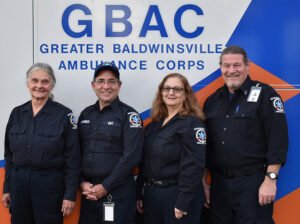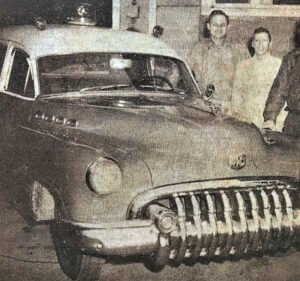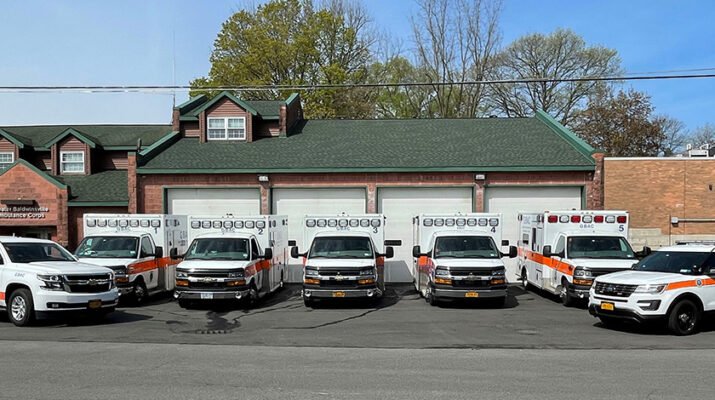Veteran members reflect on decades of service to community
By Stefan Yablonski

The Greater Baldwinsville Ambulance Corps celebrated its 60th anniversary in 2022.
The agency started in 1962. It was neighbor-centered and “the community was thrilled to have this remarkable healthcare benefit in their town,” said Bob Sweet, the organization’s vice president. “GBAC was just the second volunteer ambulance in the state of New York.”
The first ambulance was a converted 1959 hearse. More than 120 volunteers signed up to ride the ‘new’ ambulance.
Vin Maresco began his emergency care career in the 1980s, serving on his college’s emergency squad; then became a member of the national ski patrol, working at Song Mountain and Greek Peak.
He became a certified New York State EMT in 2019. In 2020, Maresco joined the Baldwinsville Ambulance team and now provides advanced EMT care.
“GBAC has been a very welcoming environment to learn and grow as an EMS provider,” he said. “The agency provides exceptional pre-hospital care for sick and injured members of the district. I’ve grown as a provider under the mentoring of the GBAC professionals.”
He also serves on GBAC’s Quality Improvement Board.
Sweet has served with GBAC for 39 years.
“This field of work is one people either love or hate. For me it’s a passion. I love everything about this business,” Sweet said.
He started at GBAC in the early 1980s when everyone was a volunteer. He became a paramedic and practiced at that level for nearly 30 years.
Today, he’s an EMT on the ambulance.
Most EMS organizations are staffed with paid, career oriented people who do this for a living today, he noted.
“When I first joined, there were only volunteers at GBAC and most other EMS operations. Now volunteers have nearly disappeared,” he said. “GBAC is fortunate to have a good mix of both.”
Sweet shares shifts with his long-time partner, Patty Moses.
A paramedic, she’s been volunteering with GBAC for 44 years and is an emergency room nurse at one of the Syracuse hospitals.
Moses is also GBAC’s historian. She’s seen significant innovations in back-of-the-ambulance patient care over the years — such as “digital stethoscopes, 12-lead diagnostic ECG machines, BiPap machines and video tracheal scopes. All of which help us to provide industry leading care in the back of an ambulance,” she said.
Another area that’s evolved is safety.
“Needles and intravenous catheters used to be open and exposed after use, increasing the probability of paramedics being stuck with a dirty needle. Today there are safer needles that automatically retract after being used, drastically decreasing the chances of exposure to blood,” she said. “In addition, our stretchers no longer need to be manually lifted into the back of the ambulance. Instead, they’re pneumatically raised by a push of a button, thus saving countless back injuries.”
Anne-Marie Howell has been involved in EMS for 47 years.
She’s a paramedic and a paramedic instructor.
 When volunteering began at GBAC in the early 1960s, “the training required to provide patient care on the ambulance was a first-aid class,” she said. “Things have changed significantly since then. Today, all EMS providers must pass a rigorous course consisting of 200 hours of classroom education and many hours working in an ambulance with a preceptor before receiving the basic Emergency Medical Technician certification. EMTs are able to assess patients, administer six different medications and treat several medical and traumatic conditions. EMTs provide what’s called Basic Life Support care to patients.”
When volunteering began at GBAC in the early 1960s, “the training required to provide patient care on the ambulance was a first-aid class,” she said. “Things have changed significantly since then. Today, all EMS providers must pass a rigorous course consisting of 200 hours of classroom education and many hours working in an ambulance with a preceptor before receiving the basic Emergency Medical Technician certification. EMTs are able to assess patients, administer six different medications and treat several medical and traumatic conditions. EMTs provide what’s called Basic Life Support care to patients.”
“The greater Baldwinsville community is fortunate to be served not only by BLS providers but Advanced Life Support care-givers as well,” she added.
In order to provide care at this level, you must be certified by the state as a paramedic.
“In order to begin the paramedic training program you must first be an active EMT. Then, you begin a nearly two-year, 1,000 hour college level course which also requires 100 hours of hospital time in several different specialties,” she said. “Paramedics also have to prove their skills ‘in the field’ with a preceptor over dozens of patient care episodes. Paramedics can administer approximately 30 different medications, capture and interpret diagnostic 12-lead Electro Cardiograms, start IVs and mechanically breathe for patients who can’t breathe on their own. Paramedics in ALS ambulances perform nearly all the same treatments for a critically ill patient that the emergency room staff would do in the first 10 minutes after arrival at the hospital.”
Howell, who has been teaching EMTs and paramedics for years, said emergency medical services “has come a very long way over the last few decades.”
“In this business, you are often interacting with people that are experiencing one of their worst days. We are especially saddened when there is loss of life,” Sweet said. “Even though we have state of the art techniques, medicines and machines, sometimes the damage to the human body is just too great.”
“I lost my father due to a traumatic injury. Although I was emotionally devastated, I was comforted knowing that he had the best chance of survival because it was GBAC, my ambulance, that responded and did everything possible to help him,” he continued.
On occasion, they’re there to help when patients are having one of their best days, he added.
“One of the best days, for patients and for EMS personnel, is when we get to help deliver a baby. Of course the mom does all the work; we just assist and are there for any complications,” he said.
There are times these care providers can experience their own increased stress because of seeing so many patients having that worst day or after experiencing a particularly distressing patient encounter.
“This is when we, the helpers, need to reach out for some emotional support,” Moses said. “There are EMS providers who are specially trained in what’s called critical incident stress debriefing. We can always reach out to them when we feel the need.”
Today, GBAC has five fully equipped Advanced Life Support ambulances and answers nearly 5,000 calls each year.
“It’s very exciting and gratifying work providing care for your neighbors,” Sweet said.
To learn more, call 315-638-4328.

